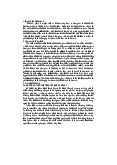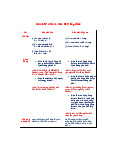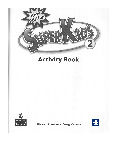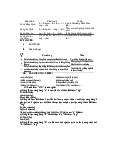








Preview text:
NGUYEN QUANG MINH 103803697 INB20009
Assignment 3 - Reflective Journal
INB20009 – Global and Digital Marketplace Table of contents: Introduction: …...
……………………………………………………………………………...2
Topic 1 : Introduction to global and digital marketplaces………………………….. …………2
Topic 2 : Global Marketspace and Virtual Neworking Web 2.0 revolution .............................3
Topic 3 : Social media and the global marketplace: Web 2.0 Business models KEY ………. .3
Topic 4: Global Consumers in the global marketplace: power of web 2.0……………………4
Topic 5 : Global Consumer Culture and constructing consumer identities in the global
marketplace……………………………………………………………………………………5
Topic 6 : Integration and Fragmentation of the Global Marketplace …………………………6
Topic 7 : Researching the global marketplace………………………………………………...7
Topic 8 : Managing Global Business Reputation in the global marketspace………………….7 Conclusion: …………... .8
………………………………………………………………………
References: …………………………………………………………………………. .……......9 1 NGUYEN QUANG MINH 103803697 INB20009 Introduction:
In the first of this assignment, I would like to present what I have learned throughout
the last semester. To apply the knowledge which we have learned in the future, we need to
rewind usually and try to keep it in mind so that we could not feel difficult in the future.
Throughout the whole semester called INB20009 also known as Digital and Global
Marketplaces, the first eight topics are shown under my brainstorm about theories of
worldwide markets, culture global consumption, and global online networks are required to
effectively exploit the global market, as is an awareness of the developing nature of the
global market and the virtual market space. My Reflections throughout 8 weeks:
Topic 1 Introduction to global and digital marketplaces. KEY CONCEPTS LEARNT:
As technology advances, network 4.0 as well as the close relationship between
business, culture and politics, the connection between people, goods and information
becomes more and more global. The market is becoming increasingly important due to the
variety of items available to customers and suppliers, as well as lower operating costs for
businesses. Cultural diversity and consumer learning are also becoming more apparent,
leading to added value and the exchange of opinions among groups of buyers and sellers
around the world. The digital space has also become a meeting place between buyers and
sellers. Instead of needing to meet in a specific location, the digital environment is a place to
connect and share information. ACHIEVEMENTS IN LEARNING:
Globalization is a multifaceted concept that has taught me about an open and
interconnected world through digital networks, and why increased activity on network
platforms generates more profitability and optimizes their efficiency. However, it also
implies that companies must strictly adhere to the standards set by the globalizing
organization in order to survive. ASSESSMENT OF LEARNING:
The introduction of concepts related to globalization through theoretical examples and
implementation of the concepts is positively evaluated. Alibaba, China's largest e-commerce
site, is a prime example of how globalization can flourish. However, the difficulties
associated with this company's penetration and fragmentation process will be studied. RELEVANCE OF LEARNING:
Facebook, Instagram, and TikTok are social networking platforms that connect m e
with people from many different cultures, a w s
ell as celebrities and new concepts I've never seen before, such a
s life. Mongolian goat farmer's daily life or traditional Italian pizza. The 2 NGUYEN QUANG MINH 103803697 INB20009
three commerce platforms I use most often and find the most adaptable are eBay, Shopee, and Tiki, which are broad i t n erms of items a w s ell a
s convenient and contain many items that
not everyone where I live can access. Purchasing takes a long time, lacks convenience, and
these platforms are challenging for many people, myself included.
Topic 2 : Global Marketspace and Virtual Neworking Web 2.0 revolution . KEY CONCEPTS LEARNT:
The main goal of Web 2.0 is to empower users, promote intimate relationships
between users, and allow them to exchange and provide useful information. With Web 2.0,
users can post anything on the Internet. Social presence theory and social presence theory are
two theories that describe how individuals perceive and interact in a virtual network related to
the web 2.0 concept of social processes. According to social presence theory, different modes
of communication lead to different levels of connection or feelings of belonging to others.
When a large amount of information has been filtered and selected by users, it becomes
extremely valuable. Web 2.0 users will feel connected to other users who are also using the
platform, and they will also express themselves and contribute to the community with their
creativity on the platform, in theory too.
ACHIEVEMENTS IN LEARNING :
Web 2.0 sites like eBay, Facebook, and Airbnb are using the platform and it is a huge
success for their users, attracting more and more people to their platform and growing it.
what I learn on these platforms will b
e invaluable if I want to develop m o y wn Web 2.0 site. ASSESSMENT OF LEARNING:
A discussion of the many advantages and capabilities of Web 2.0 to provide lasting
value to users. I am sure that by understanding and applying market research methods to
segment customers, I have partially understood the relevance and impact of Web2.0
applications and marketing models and sales. RELEVANCE OF LEARNING:
Users are more interested and surprised when they ca a n ctively contribute and participate i t
n he process when using Web 2.0 functionality as opposed to Web 1.0 which
only allows users to passively receive information. values, outputs, and content, I ca now n
show how different virtual and voice cues across digital platforms can impact how self-
identity and perception are perceived. Self-forming refers to the two virtual network theories
of the virtual networks indicated above and how to b
e concerned with self and others.
Topic 3 : Social media and the global marketplace: Web 2.0 Business models KEY KEY CONCEPTS LEARNT: 3 NGUYEN QUANG MINH 103803697 INB20009
4C Business Models, also known a F
s our Basic Business Models, is an abbreviation
for the Content, Commerce, Context and many services offered by the Connect platform
(Wirtz 2000, p. 218). This approach increased efficiency, replaced outdated trading methods,
and focused on online interaction between sellers and buyers while offering additional item
types beyond shipping, trading, and quantity. Web 2.0 The phenomenon i c s losely related to
four basic characteristics: Social networks represent a i
n ndividual's online social structure,
including social identity, trust, and purchasing power. Adaptation and adaptation of
instructions for users on how to set up the website. User value refers to the ability of users to
contribute content, and engagement orientation refers to the nature of online interactions
between a company and its customers. ACHIEVEMENTS IN LEARNING:
Learning about the 4C business model has given me a better understanding of platforms such a e
s Bay, Facebook, and Instagram, and their power to serve multiple
customers and sellers while delivering power. Creating customized content for the seller that
benefits both the seller and the platform itself, allowing more people to sell their products on
his eBay and Amazon, and driving traffic to the site. Facebook will also be a place for
individuals to resell their stuff to groups. ASSESSMENT OF LEARNING:
Explaining globalization-related issues with theoretical examples and conceptual
implementations is positively rated. Alibaba, China's largest e-commerce platform, is one of
the best examples of how globalization can succeed. However, issues regarding the
company's intrusion and fragmentation processes are under investigation. RELEVANCE OF LEARNING:
With many businesses moving their primary operations to the Internet, understanding
the possibilities of Web 2.0 and the different types of online business models will no doubt
help you with your future business goals. After choosing the right 4C model type, w w e ere
able to extend the platform further by incorporating Web 2.0 elements such a us s er-generated
content, personalization, advanced social identity, and customer feedback.
Topic 4: Global Consumers in the global marketplace: power of web 2.0 KEY CONCEPTS LEARNT:
Network 2.0 is the online interaction between people, ideas and websites. Web 2.0
changed the one-to-many connections or links from one site to another. Users ca a n ccess
many-to-many relationships by establishing new multipath connections. Leveraging information technology i ge n
neral and her web technology i pa n rticular, Web 2.0 and its
applications have created "social phenomena" such a A s
mazon, Facebook, Youtube, etc.
Strengthen the diversity of service delivery approaches to meet user needs. Making the most
of the largest online resource to minimize the time and paths required to create, organize and
distribute information to keep consumers informed. 4 NGUYEN QUANG MINH 103803697 INB20009 ACHIEVEMENTS IN LEARNING:
The rise of Web 2.0 means the development of transnational cultures and the
opportunity for many companies to enter many new countries, but we also need to be careful
before contacting them. How to market your services without knowing your own culture and
people first. The company's campaign, therefore, reflects the country's tradition of excellence
without harming the future of its customers and without damaging the company's reputation in the world market. ASSESSMENT OF LEARNING:
The presentation of internationalization-related topics i s constructively considered
using logical examples and conceptual implementations. Alibaba, China's largest e-commerce site, i
s a shining example of how to thrive i g
n lobalization. The difficulties this tissue has i n
the process of penetration and fragmentation are examined. RELEVANCE OF LEARNING:
Social networks are the fastest way to communicate, but they are also a double-edged
sword because they can quickly spread good and bad news and users are uncertain about
what they will leave on their accounts. A
s a result, platforms need a thorough understanding
of culture, government, and dos and don'ts to prevent the spread of negative messages and build people's trust i t n he organization.
Topic 5 : Global Consumer Culture and constructing
consumer identities in the global marketplace KEY CONCEPTS LEARNT:
Consumer culture refers to the core cultural norms and practices of a society and the
attitudes, interests, and traits associated with consumption. From a value perspective, this
theory sees consumer culture a a
s ll values related to consumption. Consumer culture i s more
than the way individuals “consume” goods. It i
s also a unique example of the relationship
between culture and consumer behavior. ACHIEVEMENTS IN LEARNING:
Consumer culture encompasses and influences many aspects of social life. Consumer culture ca boo n
st the economy by facilitating the purchase of both physical and intellectual
goods. The study of consumer culture i s important and important i n understanding culture, but it i a
s lso critical and important i
n helping build modern societies and i s inseparable from
national economic growth. Identity and traditional values can safely and responsibly connect with the world i
n today's context of globalization. ASSESSMENT OF LEARNING:
Explanations of internationalization ideas are constructively evaluated through
theoretical examples and conceptual implementations. Alibaba, China's largest e-commerce 5 NGUYEN QUANG MINH 103803697 INB20009 platform, i
s a shining example of how globalization can succeed. However, issues regarding
the company's intrusion and fragmentation processes are under investigation. RELEVANCE OF LEARNING: Consumer culture i
s more than just culture. It i s also a social framework i w n hich there is a e
n ssential correlation between social resources, lifestyles, and cultural experiences
in everyday life. Basic items and symbols for people are provided through market agents.
Consumer culture is a set of consumption habits that can b s
e een everywhere at any time. The
use of trade goods affects this. It i a
s lso the art of transmitting cultural beliefs, prevailing
practices, and patterns of behaviour from one generation to the next, primarily through an
individual's everyday choices.
Topic 6 : Integration and Fragmentation of the Global Marketplace KEY CONCEPTS LEARNT:
In business, schism occurs when an organization splits or disbands due to differences
in leadership and control management, when an organization shows signs of splitting, and
when companies merge. “Dive in” to help your business grow and develop. A business
combination is a process by which one company acquires another company and integrates its
business, and may be accomplished through acquisition, merger, or acquisition of the previous company's business.
Consolidation can effectively and efficiently increase the size of a company. Growth
helps businesses provide employees with jobs that meet changing requirements. Additionally,
it can provide businesses with additional resources to expand their sales territory and improve
their products. Regardless of the region of fragmentation, adjustments and mergers can be
difficult and usually face internal resistance. The value of the change must be properly
communicated within the organization to bring the change to the point where senior-level support is required. ACHIEVEMENTS IN LEARNING:
These benefits include reduced costs through increased efficiency. Employees may be
skeptical of cost-cutting intentions and resistance to change, so it is desirable to focus on
improving performance in terms of motivation, turnover, and changes in balance. No
employment risk. This means that each department has different responsibilities and low-
level activities, including communication with other departments. Openness and
communication within an organization are essential for breaking process fragmentation,
integrating into new companies with clear goals, increasing profitability, and developing new markets for the company. RELEVANCE OF LEARNING:
Personally, I believe that buying and integrating services from other organizations can be a win-win for companies i t
f hey struggle with management and integration results. of
consumer electronics companies acquire another company of the same size and type, but sell
services from a more profitable competitor to the combined company, business integrators 6 NGUYEN QUANG MINH 103803697 INB20009 are likely to b
e more productive and successful. When a company acquires a competitor, it
can make the market less competitive. When there i
s less competition, businesses have more
price control. It also provides opportunities to expand sales territory and develop new items and services for customers.
Topic 7 : Researching the global marketplace KEY CONCEPTS LEARNT:
The growth and popularity of the Internet have enabled a global consumer base to
actively criticize companies. These customers have something in common with brand
communities that connect those who interact with businesses and foster a sense of community
among consumers. There is an issue of global activism that needs to be addressed to avoid
anti-brand groups and dissidents. ACHIEVEMENTS IN LEARNING:
Social media and its communication tactics can have a negative impact on market
penetration and globalization. Administrators and businesses need to analyze vulnerabilities
in order to propose solutions that increase customer pride in Internet 2.0 systems. Complaints
and help system should be developed to keep dissatisfied customers alert and satisfied. ASSESSMENT OF LEARNING:
Alibaba, China's largest e-commerce platform, i
s a shining example of how to thrive
in globalization. The difficulties associated with this company's process of penetration and
fragmentation are examined. It is appropriate to assess learning growth through conceptual
applications and theoretical examples related to globalization. Concepts and ideas should be
used for the purpose of improving and optimizing the process and results of globalization. RELEVANCE OF LEARNING:
H&M and Zara have been identified a e
s xamples of customer relationship
management (CRM) abuse, leading to conflict and unfriendly behavior.
Topic 8 : Managing Global Business Reputation in the global marketspace KEY CONCEPTS LEARNT:
Even if many experts have screwed up, the trend and risk for the next few years are
that things will become a reputational disaster. Many small risks have accumulated to the
point where damage to a company's reputation is unpredictable. need not be repeated. Today,
a company's reputation is tied not just to its products, but to the stories that personally
influence the CEO as an employee or as a neighbor to an employee. Each of these stories
grew into stories read, discussed, and analyzed by millions of people, plaguing the company.
The reputational risks faced by businesses are often related to the quality of their
products and services. This is followed by safety, health and environmental concerns, and
political threats (impacts on business). There is also danger from competitors and indirect
threats. Businesses need to plan for third parties (partners, suppliers, distributors, or industries). 7 NGUYEN QUANG MINH 103803697 INB20009
ACHIEVEMENTS IN LEARNING :
The trend and concern over the next few years are that even a few small pros tear it up
and it could become a reputational disaster. You don't have to repeat Today, the stories that
influence a company's reputation include not only the product, but also the individual CEO,
employees, and even someone's neighbors within the organization. All of this has become a
story that millions of people talk about and speculate about, with disastrous consequences for the company.
In addition to maintaining and improving the quality of their goods and services,
businesses need to understand how customers, stakeholders, consumer advocacy groups, and
the general public view them and their competitors. I have. Learn about industry rivalries and
gain control over customer expectations and opinions. Spend money on services to obtain
such information. For example, reading newspapers (media clipping) and doing social
listening is essential, especially for businesses that sell goods and services to their customers. RELEVANCE OF LEARNING: I think it i
s important to inform all employees about trademark protection. For advice
to consumers, the communications team should contact the sales team or the customer service
team (customer service representatives often don't know what to do or how to deal with
inappropriate behavior). working with clients). Customers create a crisis by forcing
themselves to expose themselves to the media. To solve the crisis, companies must prioritize
people, environment and assets. Event or Crisis Disposal must comply with regulatory
obligations and cultural and ethical norms. Dealing with the consequences of a crisis is far
more costly than dealing with the problem itself, so i t
n he event of a failure, all available
resources must be used lavishly.
All organizations should have a reputation management communication plan i p n lace
for effective crisis management and crisis prevention. This can b e seen a o s ne of the
requirements for companies to b
e able to sustainably expand i t n oday's highly risky and
competitive market. With the help of experienced reputation managers, organizations can
better anticipate the dangers and crises they are likely to face, design solutions that work for
each event, seek advice on the best communication channels, and improve their post-crisis reputation. Conclusion:
The most important parts of the eight subjects are used to examine and discuss key
concepts related to digital and international markets. Ideas explored include globalization,
digital marketplaces, Web 2.0, the 4C business model, his five axioms of social media, social
media risk management, standardization and alignment of global marketing needs, online
consumer behavior, and internet ethics. included. After briefly presenting each idea with a
theoretical framework and insights, key insights from the study materials are explained and explored i t
n his reflective notebook. Evidence to support the learning process, feedback from 8 NGUYEN QUANG MINH 103803697 INB20009
others to revaluate and improve what was learned, and finally, personal relevance to the
specific information to which the learner feels an emotional connection are all mentioned here. REFERENCES:
Thierry, I., & Lescop, D. (2010, February 27). Open innovation within business ecosystems:
A tale from Amazon.com. Retrieved November 25, 2022, from
https://papers.ssrn.com/sol3/papers.cfm?abstract_id=1559085
Kopp, C. (2022, November 07). What is organizational behavior (OB), and why is it
important? Retrieved November 25, 2022, from
https://www.investopedia.com/terms/o/organizational-
behavior.asp#:~:text=What%20Is%20Organizational%20Behavior%20(OB)%3F,make
%20businesses%20operate%20more%20effectively
Alibaba marketing strategy and case study. (2021, March 26). Retrieved November 25, 2022,
from https://www.ciim.in/alibaba-marketing-strategy-case-study/ 9




